How long is it supposed to take to drive across town?
Your answer to that question probably depends, more or less, on how long it took to do so when you moved to town.
That’s one of the ideas behind a comment BikePortland reader Carl Abbott added to Tuesday’s story about this week’s experimental redesign of Naito Parkway. Extrapolating a bit from the Naito situation, Carl speculated that as Portland’s buildings fill in and grow up, its streets might start filling up, too.
By reallocating traffic lanes on streets defined as having excess capacity, the city is essentially engaged in a citywide traffic slowing enterprise as drivers will keep seeking out alternative routes until all arterials move at the same slower speed (see the classic essay on The Law of Rush Hour Traffic Congestion by Anthony Downs). How the next 100,000 Portlanders fit with this goal is not clear, but there will certainly be tensions along the lines of the apartments without parking spaces conflict.
Advertisement
If those next 100,000 Portlanders make the same transportation choices that Portlanders make today, our city will choke on its own traffic. Meanwhile, it’ll get politically harder and harder for the city to do what it needs to do in order to change that fate: to reduce the space dedicated to cars in order to improve more space-efficient modes like mass transit, walking and biking.
It’s worth noting that on many Portland streets (for example, Southeast Powell and Southwest Barbur boulevards) traffic has actually been falling despite the region’s steadily rising population. But it’s not clear whether that’ll continue — and if it doesn’t, it’s all the more reason that today’s generation of Portlanders owes it to those who’ll come in the future to act to improve our city while we can. Let’s find ways to reassign our road space before it’s too late.
Yes, we pay for good comments. We’ll be sending $5 and a little goodie bag to Carl Abbott in thanks for this great one. Watch your email!


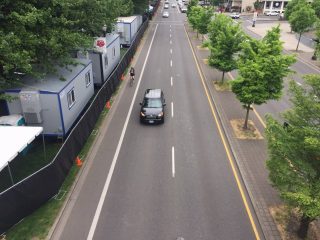
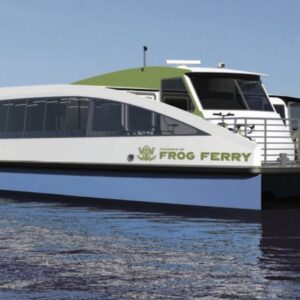
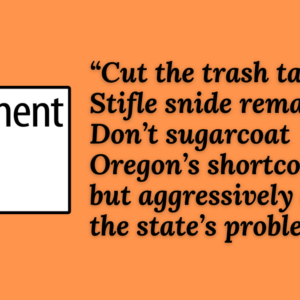
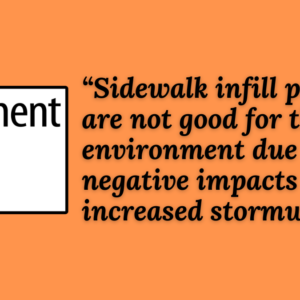
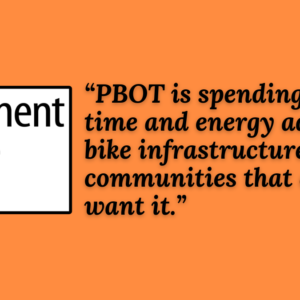
Thanks for reading.
BikePortland has served this community with independent community journalism since 2005. We rely on subscriptions from readers like you to survive. Your financial support is vital in keeping this valuable resource alive and well.
Please subscribe today to strengthen and expand our work.
I went out of my way to try the revised bikeway. Hopefully it will wind up as a permanent fixture and model for other thoroughfares. If front became a single lane both ways It would be glorious almost as good as when the Journal building was demolished and left Front avenue and eliminated Harbor drive. Or am I dating myself?
We need to reassign road space to fixed rail tranit. The streetcar and MAX need expansions. The SW corridor needs to be MAX. The line connecting Orange and Green MAX will eventually need to be upgraded to grade separated, somehow, if it’s to carry more passengers. We need 24-hour MAX/bus service to attend to workers that aren’t on a typical schedule. Gateway needs a streetcar circulator to spark a new downtown around i-205– this will bring needed resources to east Portland. We need widespread protected bikelanes DONE RIGHT. We need new bike highways; Sullivan’s Gulch screams for one. We need more coherence in our politics over the whole metro area; balkanization is killing us right now. We need less NIMBY intervention in the political process; this means avoid the temptation of changing our local government to overrepresent specific districts. At-large is enough representation.
All these improvements WILL offset traffic and allow us to densify housing to our heart’s content. If we do this now, there will never be a political crunch for infrastructure (that isn’t car); history will simply prove it’s a necessity during heavy growth.
We need to take money from ODOT, and we must only maintain, not expand, our highways/roads.
When we begin to plan for movement of PEOPLE by many modes, rather than movement of vehicles, or priority only on limiting seconds of delays to travel time, it will be easier to consider and plan for an influx of population.
Recognizing that every road is different, here is an example:
Today, 1,000 people: in 700 cars, 6 buses, and 40 pedestrians on a sidewalk travel a road in an hour. “No room for bike lanes!”
Tomorrow, 1,000 people: in 200 cars, 12 buses (High Capacity Transit), 250 bicycles and 150 pedestrians on a sidewalk travel a road in an hour.
We’re all still getting there. And, really, there’s plenty of room for all, but our transportation departments have to recognize that Not. Everyone. Wants. To. Or. Can. Drive. A. Car. — & start truly planning like people matter.
“Let’s find ways to reassign our road space before it’s too late.”
There is another way to look at this. In a few short years, whether we’ve reassigned road space in the ways discussed above or not, a much larger share of all roads will open up to human powered modes because the motorized approach we’ve all gotten so used to will have started to dry up and blow away. I know it is hard to imagine from where we sit here in mid-2015, but if this blog is around in a few years we should revisit this, see just have quickly the hard to conceive became our new reality.
“In a few short years…”
i wish. hopefully, in a decade or two we will begin to see internal combustion engine transport dry up and blow away.
How will 100k more people get around?
They won’t, unless city hall and ODOT take huge strides in prioritizing mass transit and alternative modes. Not this nibbling at the edges crap like SW Stark.
Start from the core and work out. For instance, we have tons of excess parking capacity downtown. Remove some for a grid of dedicated separated bikeways.
24-hr TriMet which does more than build new MAX lines and let them rot for the next 20. Which has its labor costs in line.
A state gas tax of % tied to inflation with proceeds going directly to counties for use only on non-auto projects.
This is going to cost real money and some people might not like everything. Also known as progress///
What if 100k people hopped on a bike tomorrow? How much would the street fee need to raise then?
This is starting to look like the Old West range wars. Hmmm…100,000 new residents who would really like fenced in safety for their bicycling ways vs. ol’ timey sov drivers grittin’ their teeth and steerin’ their way according to the old fashioned “automobile values.”
It would really help to apply a little construction knowledge to these issues instead of turning it into, or letting it become, and us vs. them political confrontation. Witness the real solution of the Hawthorne Bridge upgrade, where both sides got what they wanted. This was because some practical construction knowledge was applied—in this case, extending the bridge framework a bit, moving the original railing, and installing wide, lightweight prefabricated walkways. And the entire Hawthorne bridge upgrade was done within a practical budget of $22 million. Contrast this with the $300 million Sellwood Bridge replacement—much in part because of the inadequate walkway.
Solutions similar to this could be done in many places, especially where steeper terrain—such as the Barbur Blvd. area—make normal roadpath construction impractical. And there may be places through the West Hills or outlying areas where prefabricated walks on support beams would allow a trail to go through, where normal roadbed construction would be difficult. On the Springwater Trail there are some bridges constructed this way. I really doubt that all of these new residents are going to be permanently car-less, unless, because of the sky high rents they can’t afford one. Better to use some innovative thinking than to make permanent presumptions.
“Contrast this with the $300 million Sellwood Bridge replacement—much in part because of the inadequate walkway.”
I thought the Sellwood was being replaced because it was falling down.
http://www.sellwoodbridge.org/?p=need-for-replacement
There used to be two trimet routes that ran over the bridge.
https://web.archive.org/web/20040322021718/http://www.trimet.org/schedule/pdf/SystemMap2003.pdf
But not anymore.
http://trimet.org/pdfs/maps/trimetsystem.pdf
I just wish more of you who leave comments here would be more honest. Just come right out and say that you want to restrict others in the use of a personal automobile. All of this nonsense about ultra expensive rail transit, reducing driving lanes for bike lanes, etc. is all just one big charade. I really love the approach, too, all of this done by state coercion, i.e., the government “planning”.
Because, what could go wrong with government central planning, right? I mean, if the technocrat class would have just gotten it’s way (aka trampling our rights and liberty), we’d have no traffic congestion, we have fancy bike ways to pedal to work from our high density living quarters. And that’s what many of you want…government-planned living quarters with nice rent controls. Sorry, but I have seen housing projects and central planning…you can move to New York or any number of prefab Chinese cities if you want.
I am definitely a big fan of induced demand for active transportation. That is, if we were to remove all the freeways and narrow the arterials to one lane in each direction, you can bet there would be a lot fewer cars in the central city.
“Induced” by who…exactly? Who is “we” that would “remove all freeways”?
Of course, if you remove roadways, there naturally would be less cars. But why is this desirable?
I am always creeped out by the ease in which many people here propose that “we” do something to others and demand that some anonymous person or persons “induce” something that satisfies their own preference.
Really, people. Are you that enamored with state planning? I mean, what? Nazi Germany would have been perfect if…? Stalin’s Soviet Union would have been great except…? The great inner city housing projects would have worked if not for…?
Really? Why the yearning for such state control and planning?
State control and planning built those highways and arterials. State control and planning maintain them. State control and planning isn’t all that bad when it gets you what you want is it?
There is a balance to be struck between providing access to a place, and maintaining a place as something worth going to. The two are competing priorities, because heavily trafficked roads are miserable to be near. Heavily used rail lines aren’t great either, but rail lines moving thousands or tens of thousands of people a day are much less destructive to the urban fabric – Naito should be closed weekends for the saturday market, MAX on SW 1st doesn’t have to be. And where they do have substantial impacts, they are easier to minimize – if necessary subways are more feasible than road tunnels, and Els (a better fit for many of portland’s wide roads) are smaller and less unpleasant to be around than elevated highways. Bike facilities have some impact on place, but much much less than cars. Portland has shifted too far towards devoting public land to provide automobile access, not enough towards access for those not in a car, and not enough developing places worth going to, or living near, in the first place. A more balanced approach is desirable.
JMak,
Your view of the world of transportation is a direct result of past practice and funding choices. You would not believe that cars are the best form of transportation if, like some countries, the government in charge 70-100 years ago invested our forefather’s taxes in a transportation system that efficiently moved people and goods instead of focusing on the vehicles. Your comments seem to imply the mythology that ‘freedom’ equals ‘unplanned’. Test your theory. Don’t save for retirement.
Moreover, it’s always notable that “freedom” means freedom to drive under this worldview. What is it about providing the option for me to drive, bike, walk, or take transit is antithetical to “freedom?”
What “worldview”?
I love how you two have invented this worldview and simply attached it to me as though it were a real position that’s been expressed by me.
Is that how you argue your preferences? Ignore what your opponent says, falsely attribute a position to them, and argue with yourself?
You are being contrarian. You certainly will come off to readers as the opposition to multimodal transit. Stop protesting so much.
My “view”? I didn’t express a view about the world of transportation. I expressed an opinion about comments posted here. Why do you feel compelled to attribute false beliefs or opinions to me??
I don’t think it’s possible to express as many opinions as you’ve expressed here and still claim that you’ve not revealed some semblance of a point of “view”. What is a view if not an amalgamation of thematically related opinions?
The sooner you can do a road diet the better. If you wait too long the roads will fill up and you’ll have an almost impossible time rightsizing them later.
SE 7th is a great example. Today it has 3-lanes with bike lanes. The bike lanes were striped in the 90s. The street is now at maximum motor vehicle capacity for the 3-lane cross section.
If this street didn’t have bike lanes, if it was instead 4-lanes, I have no doubt it would be carrying far more motor vehicle traffic than it is currently. And if a proposal were put forth to road-diet the street, it would face severe opposition due to concerns about diversion, delay and capacity.
This is why Sandy needs a diet now.
But, of course, there would be greater volume if there were greater capacity. What is your point? Is your point as stated in the article above, “Meanwhile, it’ll get politically harder and harder for the city to do what it needs to do in order to change that fate: to reduce the space dedicated to cars in order to improve more space-efficient modes like mass transit, walking and biking”?
Why does this “need” to be done? Portland has demonstrated that mass transit not only does not “work” but it is hugely expensive. Portlanders have demonstrated that they will not, en masse, use mass transit nor are they willing to walk and bike to work, the gym, the grocery, etc. This will not change despite your insistence that it “needs” to happen.
When we say something is politically hard, we’re really saying it is politically unpopular. And when, like the author above says, that something will be politically harder in the future so we must do that something now, he is really saying that he, and a few like-minded friends, knows better than the rest of us what is good for us and, therefore, we must skip the political process altogether.
No. Just stop. Again, why the eagerness for state central control and planning? Yeah, Stalin made the trains run on time…and he also murdered 10 million people. What can go wrong with central planning…
We ought to be weary and cautious when people start talking as Michael does above. The political process exists precisely to resolve differences in preferences. Otherwise, we resort to force and coercion to resolve those differences. What Michael, well, what many here at this website, resort to is nothing short of coercion in the form of shaming and the arrogant belief that they simply know better.
China is the contemporary example of this belief that the technocrat, that central planning will make things all better. Hundreds of thousands of people just removed from their land to make way for ghost cities full of factories all because the central government determined the siting. No time for democracy. This is Tom Friedman’s wet dream (you know, the NYT writer).
No thanks. We live in a democracy, despite the recent spate of abusing the courts to get your way when you can’t win at the ballot box. We resolve our political differences at the ballot box.
Please, please, please, stop with this nonsense that “we” should do this; that the government should “induce” preferred behavior; etc.
Mr JMak,
I’m not talking about inducing anyone’s behavior. I’m talking about providing people a place to ride bicycles safely on public streets.
Funny, I didn’t say that you were. You did see who I quoted, right??
Curious you choose a traditionally communist country as your example of central planning. You might as well have used several of the Scandinavian countries. Of course, those examples do not illustrate your world view.
Funny thing about theories. You may not ever prove them, but it only takes one case to disprove them.
Well, QED, right? Communist governments are the epitome of state central planning, no? So why wouldn’t it be appropriate to cite a representative example? You have an issue with that?
Funny, here’s another poster attributing false beliefs to me. Note that the poster, without knowing anything about me, feels compelled to tie me to a worldview and then attempts to disparage me via such a false attribution. Why?
And then this same poster goes on about selecting one case to disprove something. It appears that he/she believes that he/she has disproven something I said. Curious, eh?
As is typical among those who seek to abuse state power to get their way, to impose their preferences, this poster simply lies about the person he/she disagrees with.
My worldview….really? There’s nothing here about my worldview. I expressed an opinion about the comments of others. I do note that you failed to address that at all. Instead, you argued with yourself about an invented worldview that you attributed to me.
Why waste that energy??
And, to top it off, 4 others agreed with this poster. I wonder why? They agree that it is logical and a valid argument to falsely attribute a “worldview” to another and then argue that? I think that’s called a logical fallacy, yeah? LOL.
Road diets take many forms. Traditionally it means removing through vehicle travel lanes. It could also take another form in Portland (and elsewhere), particularly east Portland. There are several roads, 122nd, Division, Holgate, Stark, that have bike lanes next to parking lanes next to on-site parking lots (large ones at that). These roads don’t need the parking lane for cars. In these instances, converting the bike lane to a buffer and the 8-foot parking lane to a bike lane, takes nothing away from the planned purpose of the roadway – motor vehicle through-put (most of them are Major City Traffic streets).
What about those few homes scattered along these roads? Remove the planter strip to provide one or two parking protected bike lanes next to the sidewalk – only on an as-needed basis.
Yes, but let’s not forget: traffic has been falling on pur arterial streets like SE Powell, because all the motorists now use SE Clinton!!!
Hyperbole like this makes other of your posts less believable. Exaggerations are like the story of the boy who cried wolf.
Remember that the highway system was primarily a national defense activity and, personally, I grant broad deference there considerng that the principal duty of a national government is national defense and public safety.
Nonetheless, my comment does not at all applaud what we have today. In fact, today’s central planners and their fans here, are the intellectual heirs of the same people that brought us the current concrete and asphalt mess that they are complaining about today.
The first intercity road and subway in the US were private endeavors. The latter one explicitly to move workers from homes in the suburbs to jobs in nyc and back.
You appeal to some unknown “balance” which is a fairy tale. There is no “balance” anyway. There are competing priorities to be sorted out and that’s what the political process is for. If on the other hand, we have people here who appeal to some unknown “we” to take away things and induce their preferred behaviors. Youre doing something similar by appealing to “balance” while avoiding defining what that really means. And that’s what it is creepy here.
It’s creepy that so many people want the imaginary arm of the state to take action that, despite being unpopular, harms others so that they themselves benefit. It basically amounts to using the state as a tool to impose rather than use the state as a source of governance. Again, it uses force and coercion to acccomolish what cannot won in the political process…which, ironically, the article’s author acknowledges abive by noting the unpopularity of what he’s advocating.
As for access, anywhere that there is car access necessarily means that bikes and peds can similarly access, except freeways. So that access problem doesnt exist. If you’re making a safety argument then we’re talking about behaviors and taking driving lanes away does not address that. P
Taking driving lanes away eliminates the easy ability to pass people driving the speed limit. So, road diets have been shown to reduce speeding. Speed being the primary factor in the severity of a crash.
“Remember that the highway system was primarily a national defense activity and, personally, I grant broad deference there considerng that the principal duty of a national government is national defense and public safety.”
Yet used almost entirely not for that purpose. And currently, old use planning with highways has killed many cities. We are repairing the damage. I certainly will not give deference to a disgusting military-industrial state. We need more social democratic ideals– public transit and biking.
“It’s creepy that so many people want the imaginary arm of the state to take action that, despite being unpopular, harms others so that they themselves benefit.”
Arguing for planning actions that benefit the majority and the underclass is far from creepy nor is it a selfish stance. Selfish are the land speculators and NIMBYs and auto-centrists who want to promote sprawl, destroy the ecosystem by fragmentation, impose shortage to spiral housing prices.
What is creepy is folks like you who obfuscate the real benefit of an inclusive society by decrying the ills of central planning. It’s underhanded. I’d be surprised if you didn’t own some land you are using as an investment and underutilizing to the detriment of the whole city.
Uh, it doesn’t matter if it is used for that or not. I made a point, you rebutted, and I responded. Now you want to introduce another tangent?
And, oooohhh, the military-industrial nonsense…I didn’t say I gave deference that cliche. I give deference in policymaking to actual and proper functions of the state, e.g., national defense, public safety.
Public transit and biking are not social democratic ideals…where do you get such nonsense from?
I did not say that arguing for actions that benefit certain groups is creepy. I said demands for state central planning and state action to compel people to drive less, walk more is creepy.I obfuscated the benefit of an inclusive society….lol. Wow, really? LOL.
K
“Public transit and biking are not social democratic ideals…where do you get such nonsense from?”
Actually, they are.
But that’s not the reason for taking away driving lanes…I guess you’re in favor of one-lane highways??
Taking lanes away for bikes or transit makes perfect sense and will ease traffic overall by taking more cars off the road.
JMak,
What is ‘the’ reason then. And who taught you there was only one reason?